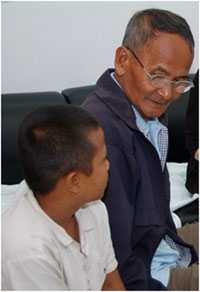A New Model of Care for Children

A grandfather and his HIV-infected grandson receive counseling at Bangkok’s Siriraj Hospital, which uses a new model of pediatric HIV counseling
Related Links
In a small, brightly colored room, a young boy sits at a table, drawing a picture. A woman sits nearby, pointing out shapes in the drawing and asking the child questions.
The situation would be familiar at nearly any daycare facility around the world. But in many hospitals in Thailand, the scene also now includes a new model of pediatric HIV counseling. During the past hour, Yuitiang Durier, a counseling psychologist at Bangkok’s Siriraj Hospital, has disclosed to the boy his HIV status, and provided counseling to both the child and his caregiver. CDC worked with staff from Siriraj Hospital, the Queen Sirikit National Institute of Child Health, and the Thailand Ministry of Health to create the new four-step procedure to identify, assess, disclose, and monitor and evaluate Thai children infected with HIV.
Currently, there are approximately 13,000 Thai children infected with HIV, but many are not told their HIV status. Some studies have found that fewer than half of HIV-infected children over 9 years old in Thailand were informed about their status.
“Recently a mother who was hesitating to tell her daughter the secret said to us, ‘I just don’t want the cycle to repeat again.’ Feelings of guilt over transmitting the virus to her daughter, worries over daughter’s emerging sexuality, confusion about her daughter’s reluctance to take her meds—these things were just paralyzing for her,” explains Kanyarat Klumthanom, a CDC staffer in Thailand who helped create the counseling model.
But keeping children’s HIV status a secret from them may put them at great risk. Children whose status is disclosed to them after puberty may have already engaged in risky behaviors. If they guess correctly about the reasons for their medicines and doctor visits, without being formally told, some children may wonder what other secrets are being withheld from them. Several studies have found that HIV disclosure helps improve children’s self-esteem and helps them develop closer relationships with their family members. Says Durier, “What most children really want is the truth—good or bad.”
Disclosing HIV status to infected children involves more than just telling children their diagnosis. The new pediatric disclosure model created by CDC and its Thai partners employs counseling techniques that aim to build relationships and feelings of trust between healthcare providers, HIV-infected children, and their caretakers. The technique helps caretakers disclose the children’s HIV status in a supportive way, through a process that emphasizes educating children about their diagnosis, facilitating communication between the caretaker and the children, and assessing and managing the impact of the disclosure.
“As these children grow up, they need to learn how to maintain their health, but they aren’t able to do this well unless they learn about the status of their illness and the appropriate method of treatment and care,” says Klumthanom. “This new counseling method allows for many factors to be taken into consideration during the disclosure process, and lets children know their status when they are ready, which helps them physically, emotionally, and socially.”
- Page last reviewed: January 2, 2015
- Page last updated: January 2, 2015
- Content source:
Global Health
Notice: Linking to a non-federal site does not constitute an endorsement by HHS, CDC or any of its employees of the sponsors or the information and products presented on the site.


 ShareCompartir
ShareCompartir